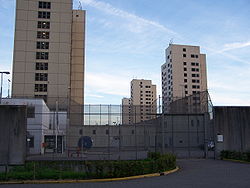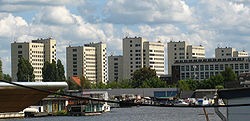
Bijlmerbajes
Encyclopedia

Prison
A prison is a place in which people are physically confined and, usually, deprived of a range of personal freedoms. Imprisonment or incarceration is a legal penalty that may be imposed by the state for the commission of a crime...
complex in Amsterdam
Amsterdam
Amsterdam is the largest city and the capital of the Netherlands. The current position of Amsterdam as capital city of the Kingdom of the Netherlands is governed by the constitution of August 24, 1815 and its successors. Amsterdam has a population of 783,364 within city limits, an urban population...
, the Netherlands
Netherlands
The Netherlands is a constituent country of the Kingdom of the Netherlands, located mainly in North-West Europe and with several islands in the Caribbean. Mainland Netherlands borders the North Sea to the north and west, Belgium to the south, and Germany to the east, and shares maritime borders...
, near the Amsterdam Amstel railway station
Amsterdam Amstel railway station
Amsterdam Amstel is a railway station in Amsterdam, the Netherlands. The station was opened on 15 October 1939. It is located south west of the station Amsterdam Centraal...
. The official name is Penitentiaire Inrichting Over-Amstel, although it is also known as Penitentiaire Inrichting De Stadspoort or Penitentiaire Inrichtingen Amsterdam. Bijlmerbajes is part of the Custodial Institutions Agency
Custodial Institutions Agency
The Custodial Institutions Agency is responsible for the incarceration of adults in the Netherlands. It is subordinate to the Ministry of Public Safety and Justice...
(Dienst Justitiële Inrichtingen, DJI) of the Dutch Ministry of Justice
Ministry of Justice (Netherlands)
The Ministry of Security and Justice is the Dutch ministry of justice. Until 14 October 2010, the ministry was just called Ministry of Justice , but at the start of the Rutte cabinet, the name changed because it had taken over some public safety duties from the Ministry of the Interior...
within the Dutch criminal justice system.
The building was designed as a humane prison without bars over the windows and was opened in 1978. However it turned out that the glass of the windows was not completely unbreakable, so bars were retrospectively fitted, known as lamellen. The complex consists of 6 towers with small divisions. The towers are connected by a tunnel through the prison, known as the Kalverstraat. The main entrance to the prison is 150 metres (492.1 ft) from the Spaklerweg metro station.
The alliterative name Bijlmerbajes was presumably acquired because the tower complex was constructed at the same time as highrise construction in the neighbouring Bijlmermeer
Bijlmermeer
The Bijlmermeer or colloquially Bijlmer is one of the neighbourhoods that form the Amsterdam Zuidoost borough of Amsterdam, Netherlands. To many people, the Bijlmer designation is used to refer to Amsterdam Zuidoost and Diemen Zuid as a pars pro toto...
, with bajes a Dutch slang term for "prison".
Towers
The six towers are each a separate prison each with a different type of prisoners and/or function. The towers are connected via the 260 m. long central corridor Kalverstraat.Besides the six towers there are also six outside areas (one for each tower), three gymnasiums or sport-centres, a small religious building functioning as church and mosque. A central front building houses some central functions such as the kitchen, visitor reception rooms, the entry processing department and the offices.
Each tower has 14 floors. Each department or pavilion has two floors connected via open stairs. Vertical transport between the pavilions and the four shared floors is possible via lifts. Two large lifts are used by the prisoners and a special small lift is only available for staff. In normal circumstances staff and inmates never share a lift.
Emergency stairs are provided on two locations: one set next to the lifts and another shaft is built on the other end of each tower.
Many activities take place on the remaining four floors, away from the pavilions. Examples are: working in the workshops on the ground-floor, library, training or education, yard-time, doctors office etc.
The total floorspace of the complex is 84.860 m2
The six towers are:
Note: HvB stands for Huis van bewaring which is the term for a prison for people awaiting sentencing or people convicted to a jailtime up to 6 months. Criminals convicted to a longer sentence then 6 months are moved to a gevangenis, but often this last term is used for an HVB as well.
Het Schouw
A standard HvB with five pavilions. Three of them offer cells with more than one prisoner (meermans cel), one standard pavilion with only single person cells and one special care unit for prisoners needing more or special attention.The special care unit has extra facilities and trained staff to house persons that need extra care, such as prisoners with psychological problems or drug-addicts.
Het Schouw offers a standard day program between 09:00 and 16:00 hrs. In the afternoon activities like sport, recreation, library, receiving visitors and yard-time.
Optional prisoners can earn some money (approximately 20 Euros per week) by performing simple work in the workshop. In HvB's work is optional, but people not working remain locked up in their cell during working hours.
The HvB is named after a bend in the River Amstel which is nearby the complex.
De Weg
De Weg (Dutch for The Road) is also a HvB for 135 prisoners. De Weg is primarily used for repeating offenders (veelplegers). The five pavilions each with 24 cells. Three of these 24 can hold multiple prisoners (normally two prisoners), the other 21 are small cells for one prisoner.For communal use each pavilion has a shared area for recreation, a kitchen and communal showers.
The day program is roughly the same as in Het Schouw
Demersluis
Demersluis is also a HvB. It can hold 125 prisoners. The five pavilions are divided into:- one providing multi-person (2) cells
- two reserved for so called arrestanten. Arrestanten are people who have failed to pay their fines or who didn't show up when sentenced to do community work.
- two (half) pavilions offer a specialized program for addicts who want to use their time behind bars to fight their addiction problems.
- the last pavilion houses a National department for dangerous prisoners. Prisoners who are deemed too dangerous to stay in a normal HvB can be detained in this section.
The program offered in the normal departments is comparable with Het Schouw. The prisoners following the program to fight their addiction follow a special program.
The HvB is named after a former sluice or locks between the River Amstel and the former Zuiderzee (now IJsselmeer
IJsselmeer
IJsselmeer is a shallow artificial lake of 1100 km² in the central Netherlands bordering the provinces of Flevoland, North Holland and Friesland, with an average depth of 5 to 6 m. The IJsselmeer is the largest lake in Western Europe....
). This name was chosen because this tower was original used as the central entrance-tower. All incoming prisoners were housed here before being placed in one of the remaining towers. Demersluis could thus be seen as a sluice between the outside world and the (rest of the) prison.
De Schans
Centre for stelselmatige daders - ISD. Criminals convicted of several -relative light- crimes within a 5 year period can be sent to an ISD. These offenders commit many relative small crimes and earlier prison sentences didn't stop them re-offending. Many of these prisoners are drug addicts who commit their crimes to finance their habit.People convited to the ISD program can be locked up for a period of 2 years, even when the normal sentence for that crime is much shorter. The relative new ISD punishment was set up to protect the society for a longer period from these criminals and offer special treatment to these criminals.
De Schans can house 120 ISD prisoners.
FOBA Het Veer
Het Veer is a special department for prisoners with severe psychological problems. Prisoners unfit to live in a normal prison can be sent to Het Veer. Het Veer is a national crisis facility to accommodate people with severe psychological problems. Het Veer can accommodate 66 prisoners; 60 male and 6 female. Some 300 prisoners are sent to Het Veer each year.Het Veer is the only facility where patients can receive forced depot medication as it is the only place with 24/7 medical staff.
On arrival in Het Veer (in most cases transferred from another prison that couldn't handle the prisoner) the patient will be observed for some time. During this period the staff will decide about an individual treatment program and all effort is given to calm down the patient.
When the patient is stabilized he will be treated for his problems until he is ready to return to a normal facility or to go to a special centre (outside or within the justice system).


